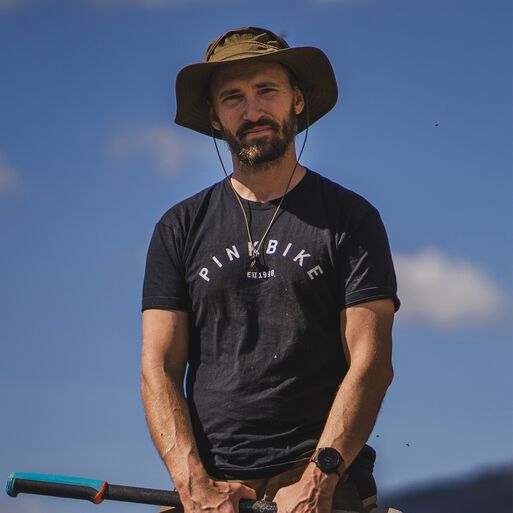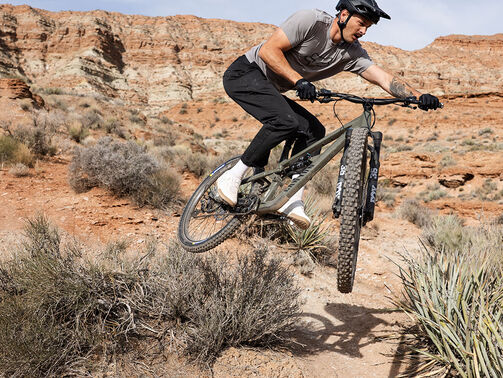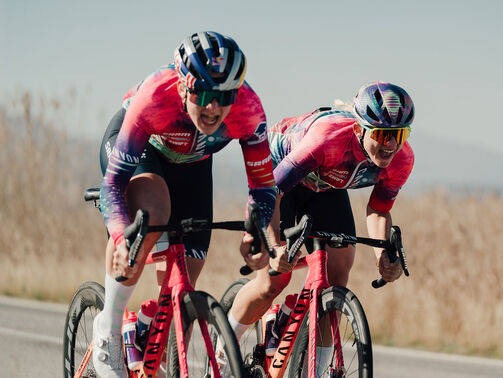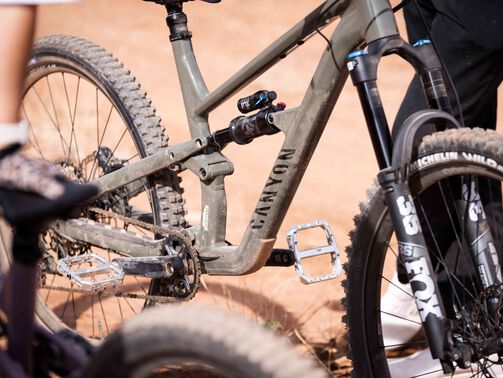How to go faster on your mountain bike
Setup, setup, setup. If you want to go faster on your mountain bike, these are the three most important words to remember.


While it is tempting to want to get out there and just go, speed changes your relationship with your mountain bike so you need to be ready for it. As you go faster, how your mtb works becomes more and more important. Something unexpected happening at 50km/h is a very different experience to 10km/h. This is why elite racers have whole teams behind them to prepare and perfect their equipment for high-speed racing. While you probably don’t need quite that much help, it is important to take the time to prepare your mountain bike well before you starting pushing your mountain bike to its limits.
Contents
Is my mountain bike safe to ride fast?
Is it safe? The most important step of all is to make sure your mountain bike is mechanically sound. You need to ask the very simplest questions - Is everything working correctly? Is everything properly attached together? Is everything in good condition?
Buying a new Canyon mountain bike, it will arrive 80% assembled with tools and instructions on how to finish setup. This means that our factory staff have fitted most of the components together, leaving just a few simple tasks for you to complete before your first ride. You can be confident that your new bike arrives nearly ready to go fast.
As your mtb gets older, parts will wear out and bolts can work loose. All bikes have many parts that wear over time like brake pads, grips, tyres, chains and cassettes - are these all still in working order? It is really important to go over the bike thoroughly to check that it is all in good condition. If you are not confident doing this, it is definitely worth asking for help from a professional mechanic so you can have safety and peace of mind.
Setting your contact points to ride your mtb fast
When you are confident that your mountain bike is safe to go fast, you can begin to look at how you connect to the bike - your contact points.
The first point to get right is the saddle height. This is important so you can pedal efficiently and be fast going up the hill as well as down it. Almost all of our mtbs come with dropper posts to help you get the saddle out of the way when the trail gets tough. If your focus is on going downhill faster on your mountain bike, you may want to make sure that not only is it a good height for pedalling, but also that it drops far enough out of the way. If you have never used a dropper post before it is worth dropping the post a few times before you set out. The goal is to be familiar with how it works so you can use it to respond to the trail conditions as easily as possible.
With somewhere to sit, you then need to hold onto your bike. Are your grips comfortable, clean and easy to hold onto? Modern mountain bike brakes are designed to only use a single finger for braking, so are your brake levers set in a position where they are positioned for you to instinctively pull in an emergency? Is your dropper post remote in a position where you can activate it without having to move your hands? Is your gear shifter lined up? The guiding principle is to have your cockpit aligned so that when you are out on the trail all of your controls are available to you without having to move or think, you should be able to react as easily as possible.

Getting your tyre pressures right
Once you are comfortable with how you connect to your bike, you can start to think about how your bike connects to the trail - the tyres (Check out our guide to a proper mountain bike pressure). If you start delving into all the possible combinations of wheel and tyre profiles, construction, compounds, inserts and pressures you will realise that it is a deep rabbit hole to dive into. What’s more, there is no hard and fast rule for what tyre will be right for you and where you ride, but our product managers work hard to make sure our bikes arrive with good tyres for the riding the bike was designed for.
For example, the Neuron our beginner-friendly full suspension mountain bike, comes with a pair of Schwalbe Nobby Nic and Wicked Will tyres in 2,4 that balance rolling resistance and weight, while our Strive enduro race bike has a super tough Maxxis Minion DHR on the back in the heavy, but puncture resistant Double Down casing so you can race without worrying about punctures.
Amongst elite racers, tyre pressures are a constant struggle - there is always a balancing act between grip, rolling speed and puncture resistance. While most people don’t need to go to such exhaustive lengths, having a suitable tyre pressure is essential for safe high speed riding.
Preparing your mountain bike’s suspension
Suspension is the final step of the preparation process to go faster on your mountain bike. If getting the perfect tyre setup felt like a lot to understand, suspension is a far more complex system with many more variables to tame. Formula One race teams have whole rooms full of people studying live suspension data when their cars are on track, all working to find the perfect settings. The challenge for a rider at home is to try and work out how much information you need to enjoy your bike fully.
For some people that might be going deep into the subject so that they can talk endlessly about topics like dynamic sag, shim profiles and air spring architecture. If you are looking at those words and thinking “that sounds like so much double dutch to me,” don’t worry. We work hard to strike a balance with the equipment our mountain bikes come with so that riders who have neither the time or the interest to understand high end suspension settings can get a quick setting and go riding. For instance, our downhill race bike, the Sender comes with full adjustability to help demanding downhill racers tune their bike to the race course ahead of them. On the other hand, our Lux World Cup XC race bike has top quality, but without all the adjustment because we know that most XC riders prefer lighter cross-country bikes, simpler suspension with a good lockout.
Checking the springs should always be the first step with suspension. To get a good riding position you need to set how much the bike sags into its travel when you sit on it - this is called sag. While there are many different combinations for you to explore, if you want to get a basic setting to head out riding, running 30% sag on the shock and around 20% on the fork is a pretty good place to start for most mountain bikes. This will mean that your fork is a little stiffer than the rear end, a combination experienced riders tend to prefer for difficult terrain. It is not just about how the fork or shock feels individually, but how the pair feel working together that will help you feel confident on the trail.
If you have air suspension, you can adjust the springs very simply with the shock pump that comes with all Canyon suspension bikes. Some of our bikes have coil suspension - using metal springs rather than air pressure - if you have one of these you may need to buy a new spring adapted to your body weight.
Then comes the hydraulic part and for this there is no simple answer - a Fox fork will require different settings to a Rockshox fork, for example. However, our suspension suppliers produce setup charts with recommended settings. These companies spend a lot of time and energy researching these settings, so you can be confident that these settings will give you a great starting point to head out and begin trying to get faster.

Techniques to go faster on your mountain bike
Once you are confident that your bikes is safe, well-adjusted and ready to be ridden hard, what are you waiting for it? It’s time to ride!
If you try and think about how to ride faster as a single thing it becomes too big and complicated to manage. It is better to break down the riding into small steps, which you can master one at a time until you feel ready to take on any trail.
As a first step, getting your posture right on the bike is a great place to start - having a solid stance on your bike is the foundation that you can build all the other skills on top of.
There is a joke amongst elite riders that jumps are for show, corners are for pros. There is a lot of truth in this, if you want to get faster, being able to rail corners with authority is an essential skill.
If you want to get faster on the uphill parts of the ride, you need to learn how to pedal smarter not harder. There are some core techniques you can learn to make sure you are getting as much of your power down onto the trail as possible using your gears.
Discover our Mountain Bikes
Did this article help?
Thank you for your feedback
-
 About the author
About the authorMatt Wragg
Get to know Matt Wragg, the freelance photographer, writer, and self-proclaimed bicycle-breaker based in Nice, France. Despite unsuccessful attempts at XC, trials, 4X, and DH racing, Matt's passion for mountain biking never waned. After a stint in communications consulting, he decided to pursue his love for cycling and moved to New Zealand. Since then, he has traveled the world, chasing trails and building a successful career as a cycling photographer and writer. In 2021, he was diagnosed as autistic and has been coming to terms with it. His bike cellar is a true testament to his love for cycling, housing bikes that range from freeride to cargo.
















